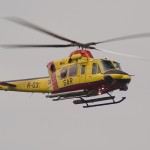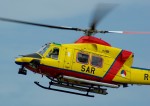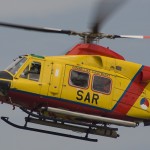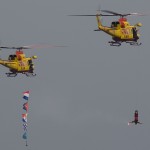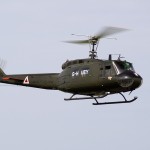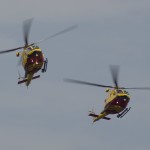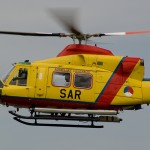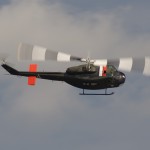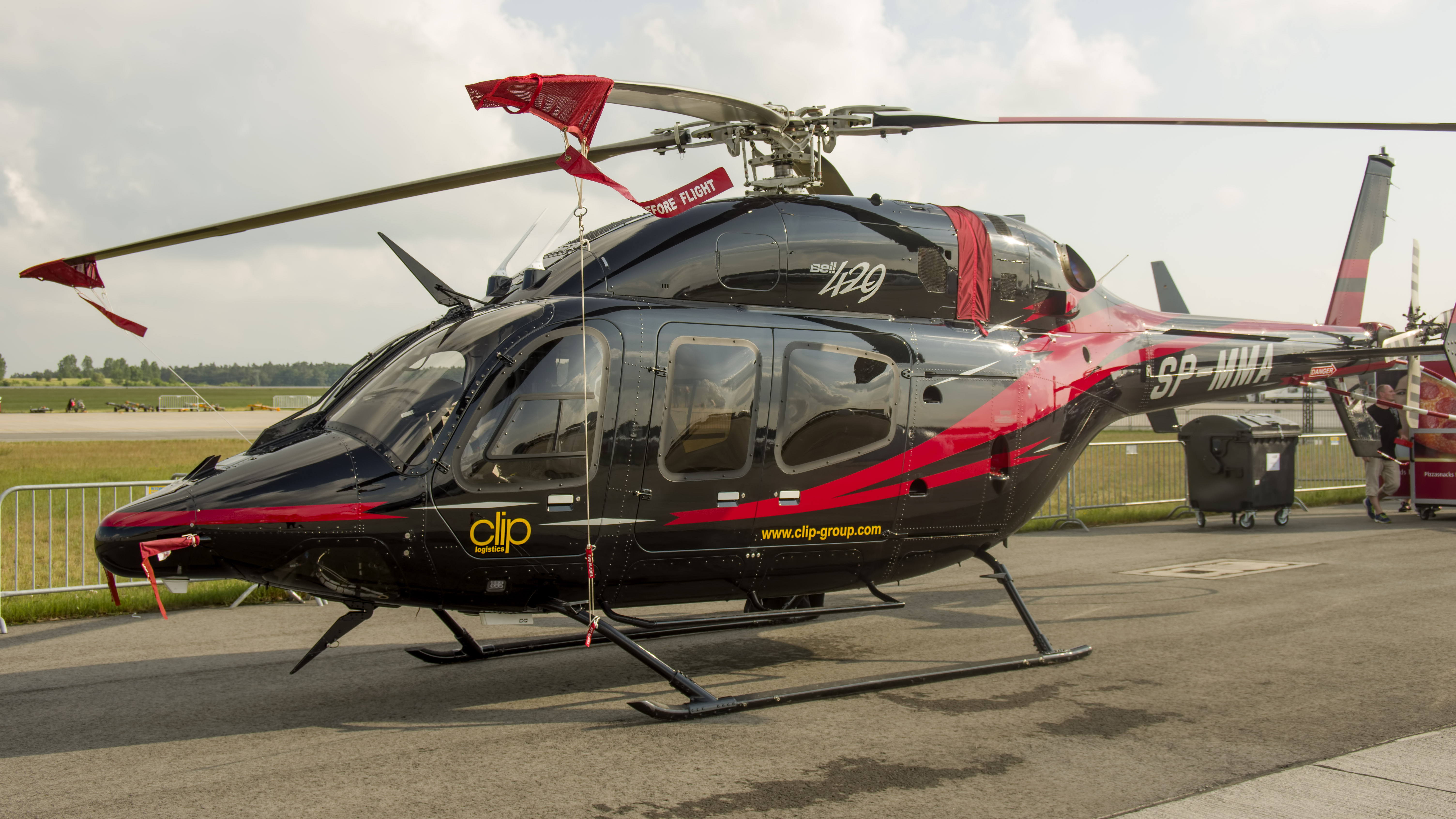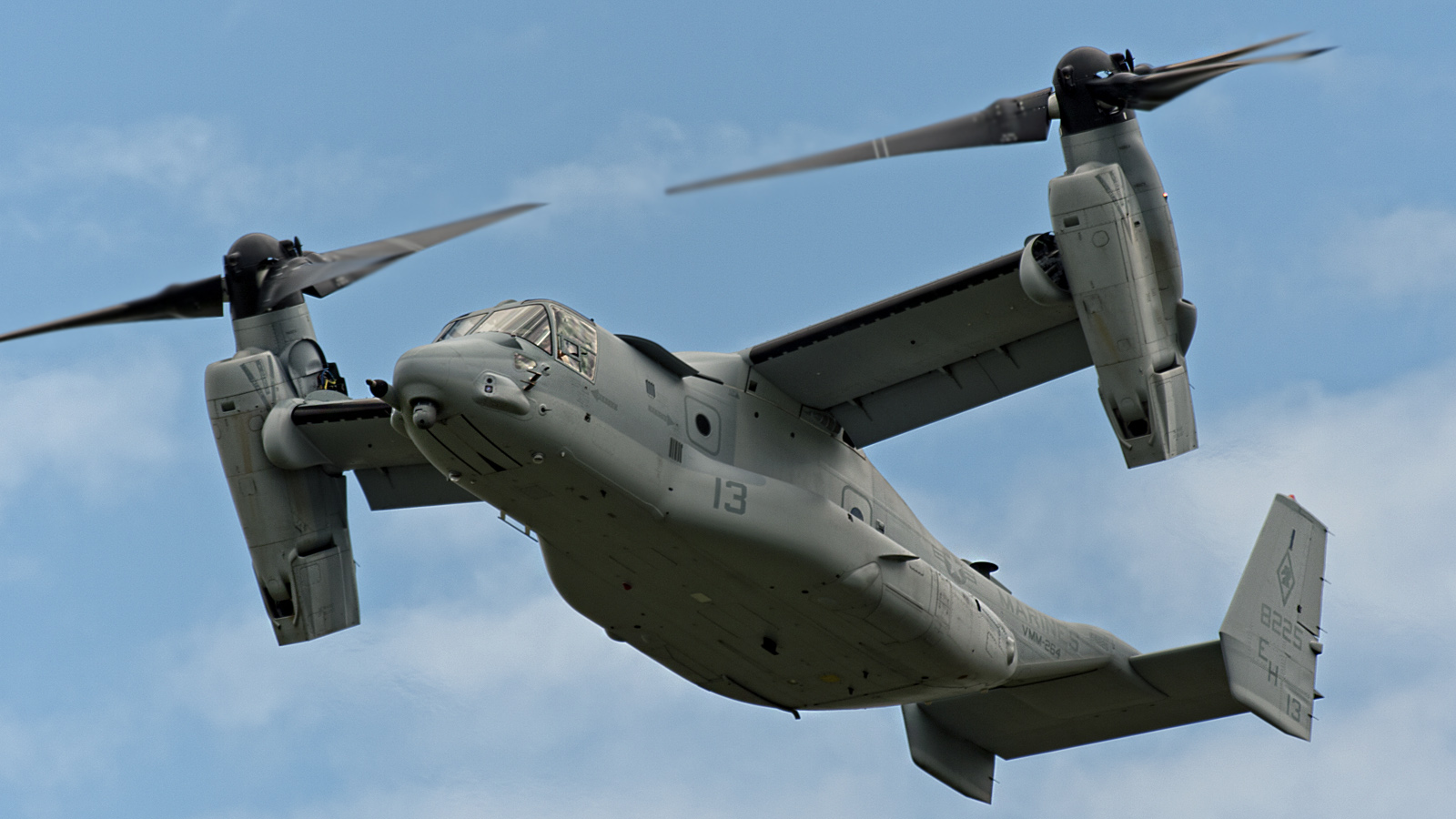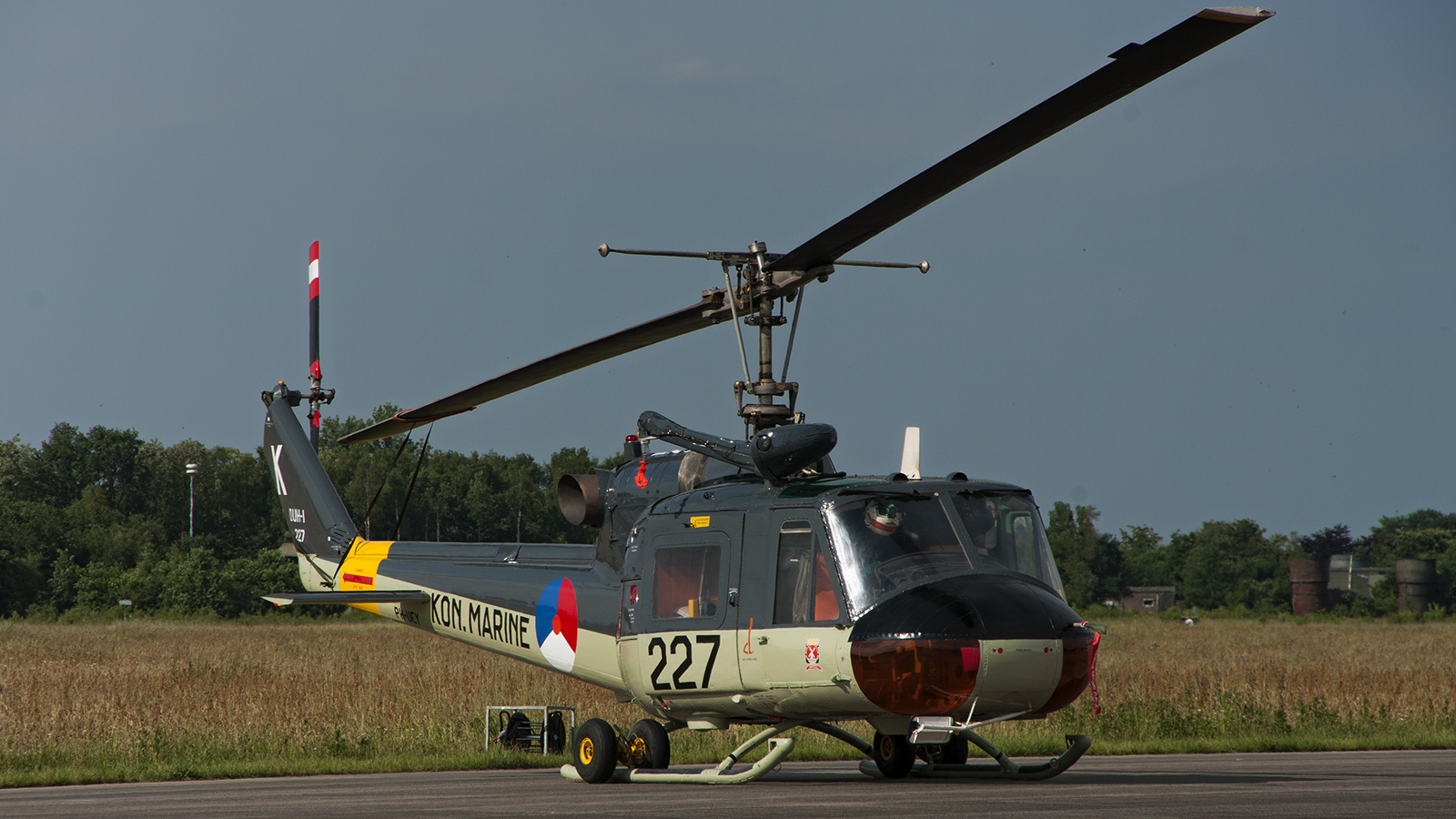
The Bell UH-1 Iroquois is a military helicopter powered by a single, turboshaft engine, with a two-bladed main rotor and tail rotor. The aircraft were used primarily to transport troops, for medical evacuations, cargo transport, and aerial attack.
Developing nation: United States of America.
Manufacturer/designer: Bell Helicopters.
Number built: >16.000.
Type aircraft: Multipurpose Utility helicopter
First flight: 22 October 1956 (XH-40).
State: in service.
Primary user: US Army.
The Bell Huey was the first mass-produced helicopter powered by a jet turbine. The helicopter was developed by Bell Helicopter to meet the United States Army’s requirement for a medical evacuation and utility helicopter in 1952, and first flew on 20 October 1956 at Fort Worth, Texas, with Bell’s chief test pilot, Floyd Carlson, at the controls. Two more prototypes were built in 1957, and the Army had previously ordered six YH-40 service test aircraft, even before the first prototype had flown. Production started in March 1960, and more than 16,000 have been produced worldwide.
The Huey has several distinctive characteristics, including its rounded nose, its twin-bladed rotor, and the loud “whomp whomp” sound it makes in flight. It is a particularly noisy helicopter because, when in forward flight, the tip of the advancing rotor blade breaks the speed of sound, creating a small sonic boom.
The UH-1 Iroquois “Huey” became an important part of American military actions beginning in 1960 and expanding throughout the latter part of the Cold War years. The ubiquitous system became synonymous with the American effort in Vietnam, no doubt due to her inherent capabilities to take on just about any needed role. Over 7,000 served in Vietnam.
Twin-engine
The single engine UH-1 variants were followed by the twin-engine UH-1N Twin Huey and later the UH-1Y Venom. Bell began development of the UH-1N for Canada in 1968. It changed to the more powerful Pratt & Whitney Canada PT6T twin-engine set. The U.S. also ordered the helicopter with the U.S. Air Force receiving it in 1970. Canada’s military, the U.S. Marine Corps, and the U.S. Navy first received the model in 1971.
In 1996, the USMC began the H-1 upgrade program by awarding a contract to Bell Helicopter for developing the improved UH-1Y and AH-1Zs variants. The UH-1Y includes a lengthened cabin, four-blade rotor and two more powerful GE T700 engines. The UH-1Y entered service with the USMC in 2008.
Huey II
The Huey II Modernization Program is the only OEM approved UH-1H performance up-grade available today. The Huey II combines all new commercial dynamic components with the reliable Honeywell T53-L-703 engine, leading to an increase in hover performance of nearly 275% in hot conditions. In addition, the Huey II up-grade increases the max gross weight to 10,500 lbs, while lowering direct operating cost by nearly 30%.
With a fielded fleet of over 150 aircraft operating in more than 10 countries, it becomes apparent that the Huey II is the preferred multi-mission, utility platform. BellAero’s US Helicopter facility in Ozark, Alabama has become the Huey II ‘Center of Excellence’, having installed over 90% of all Huey II kits to date. In addition to the kit installation, US Helicopter completely refurbishes the UH-1H basic airframe, provides a complete re-wire package, up-dates the Avionics, and offers a comprehensive selection of mission-specific kits and customizing.
Specifications (UH-1D)
General characteristics
- Crew: 1-4
- Capacity: 1.760 kg (3,880 lb) including 14 troops, or 6 stretchers, or equivalent cargo
- Length: 17.40 m (57 ft 1 in) with rotors
- Wingspan: 14.63 m (48 ft 0 in)
- Width: 2.62 m (8 ft 7 in) (Fuselage)
- Height: 4.39 m (14 ft 5 in)
- Empty weight: 2,365 kg (5,215 lb)
- Gross weight: 4,100 kg (9,040 lb)
- Max takeoff weight: 4,309 kg (9,500 lb)
- Powerplant: 1 × Lycoming T53-L-11 turboshaft, 1,100 shp (820 kW)
- Main rotor diameter: 14.63 m (48 ft 0 in)
Performance
- Maximum speed: 217 km/h (135 mph; 117 kn)
- Cruise speed: 201 km/h (125 mph; 109 kn)
- Range: 507 km (315 mi; 274 nmi)
- Service ceiling: 5,910 m (19,390 ft) (Dependent on environmental factors such as weight, outside temp., etc)
- Rate of climb: 8.92 m/s (1,755 ft/min)
- Power/mass: 0.15 hp/lb (0.25 kW/kg)
Armament
Variable, but may include a combination of:
- 2× 7.62 mm M60 machine gun, or 2x 7.62 mm GAU-17/A machine gun
- 2× 7-round or 19-round 2.75 in (70 mm) rocket pods
- 2× 7.62 mm Rheinmetall MG3 (German Army and German Luftwaffe)
- 2× .303 Browning Mk II (Rhodesian, twin machine guns mounted on port side)
U.S. Military variants
- XH-40: The initial Bell 204 prototype. Three prototypes were built, equipped with the Lycoming XT-53-L-1 engine of 700 shp (520 kW).
- YH-40: Six aircraft for evaluation, as XH-40 with 12-inch (300 mm) cabin stretch and other modifications.
-
- Bell Model 533: One YH-40BF rebuilt as a flight test bed with turbofan engines and wings.
- HU-1A: Initial Bell 204 production model, redesignated as the UH-1A in 1962. 182 built.
- TH-1A: UH-1A with dual controls and blind-flying instruments, 14 conversions.
- XH-1A: A single UH-1A was redesignated for grenade launcher testing in 1960.
- HU-1B: Upgraded HU-1A, various external and rotor improvements. Redesignated UH-1B in 1962. 1014 built plus four prototypes designated YUH-1B.
- NUH-1B: a single test aircraft, serial number 64-18261.
- UH-1C: UH-1B with improved engine, modified blades and rotor-head for better performance in the gunship role. 767 built.
- YUH-1D: Seven pre-production prototypes of the UH-1D.
- UH-1D: Initial Bell 205 production model (long fuselage version of the 204). Designed as a troop carrier to replace the CH-34 then in US Army service. 2008 built many later converted to UH-1H standard.
- HH-1D: Army crash rescue variant of UH-1D.
- UH-1E: UH-1B/C for USMC with different avionics and equipment. 192 built.
- NUH-1E: UH-1E configured for testing.
- TH-1E: UH-1C configured for Marine Corps training. Twenty were built in 1965.
- UH-1F: UH-1B/C for USAF with General Electric T-58-GE-3 engine of 1,325 shp (988 kW). 120 built. Originally designated H-48.
- TH-1F: Instrument and Rescue Trainer based on the UH-1F for the USAF. 26 built.
UH-1H: Improved UH-1D with a Lycoming T-53-L-13 engine of 1,400 shp (1,000 kW). 5435 built.
- TH-1F: Instrument and Rescue Trainer based on the UH-1F for the USAF. 26 built.
-
- CUH-1H: Canadian Forces designation for the UH-1H utility transport helicopter. Redesignated CH-118. 10 built.
- EH-1H: Twenty-two aircraft converted by installation of AN/ARQ-33 radio intercept and jamming equipment for Project Quick Fix.
- HH-1H: SAR variant for the USAF with rescue hoist.30 built.
- JUH-1: Five UH-1Hs converted to SOTAS battlefield surveillance configuration with belly-mounted airborne radar.
- TH-1H: Recently modified UH-1Hs for use as basic helicopter flight trainers by the USAF.
- UH-1G: Unofficial name applied locally to at least one armed UH-1H by Cambodia.
- UH-1J: An improved Japanese version of the UH-1H built under license in Japan by Fuji was locally given the designation UH-1J. Among improvements were an Allison T53-L-703 turboshaft engine providing 1,343 kW (1,800 shp), a vibration-reduction system, infrared countermeasures, and a night-vision-goggle (NVG) compatible cockpit.
- HH-1K: Purpose built SAR variant of the Model 204 for the US Navy with USN avionics and equipment. 27 built.
- TH-1L: Helicopter flight trainer based on the HH-1K for the USN. A total of 45 were built.
- UH-1L: Utility variant of the TH-1L. Eight were built.
- UH-1M: Gunship specific UH-1C upgrade with Lycoming T-53-L-13 engine of 1,400 shp (1,000 kW).
- UH-1N: Initial Bell 212 production model, the Bell “Twin Pac” twin-engined Huey
- UH-1P: UH-1F variant for USAF for special operations use and attack operations used solely by the USAF 20th Special Operations Squadron, “the Green Hornets”.
- EH-1U: No more than 2 UH-1H aircraft modified for Multiple Target Electronic Warfare System (MULTEWS).
- UH-1V: Aeromedical evacuation, rescue version for the US Army.
- EH-1X: Ten Electronic warfare UH-1Hs converted under “Quick Fix IIA”.
- UH-1Y: Upgraded variant developed from existing upgraded late model UH-1Ns, with additional emphasis on commonality with the AH-1Z.
Other military variants
- Bell 204: Bell Helicopters company designation, covering aircraft from the XH-40, YH-40 prototypes to the UH-1A, UH-1B, UH-1C, UH-1E, UH-1F, HH-1K, UH-1L, UH-1P and UH-1M production aircraft.
- Agusta-Bell AB 204: Military utility transport helicopter. Built under license in Italy by Agusta.
- Agusta-Bell AB 204AS: Anti-submarine warfare, anti-shipping version of the AB 204 helicopter.
- Fuji-Bell 204B-2: Military utility transport helicopter. Built under license in Japan by Fuji Heavy Industries. Used by the Japan Ground Self-Defense Force under the name Hiyodori.
- Bell 205: Bell Helicopters company designation of the UH-1D and UH-1H helicopters.
- Bell 205A-1: Military utility transport helicopter version, initial version based on the UH-1H.
- Bell 205A-1A: As 205A-1, but with armament hardpoints and military avionics. Produced specifically for Israeli contract.
- Agusta-Bell 205: Military utility transport helicopter. Built under license in Italy by Agusta.
- AIDC UH-1H: Military utility transport helicopter. Built under license in Taiwan by Aerospace Industrial Development Corporation.
- Dornier UH-1D: Military utility transport helicopter. Built under license in Germany by Dornier Flugzeugwerke.
- Fuji-Bell 205A-1: Military utility transport helicopter. Built under licence in Japan by Fuji. Used by the Japanese Ground Self Defence Force under the designation HU-1H.
- Bell Huey II: A modified and re-engined UH-1H, significantly upgrading its performance, and its cost-effectiveness. Currently offered by Bell to all current military users of the type.
- UH-1/T700 Ultra Huey: Upgraded commercial version, fitted with a 1,400-kW (1900-shp) General Electric T700-GE-701C turboshaft engine.
Civil Variants
Bell 204
Bell Helicopter’s company designation of the UH-1B.
- Bell 204B – Civil or military utility transport helicopter, derived from the UH-1B. Powered by a T53-09A, max weight was 8,500 lbs, max passengers, 10.
- Agusta-Bell AB 204 – Civil or military utility transport helicopter. Built under licence in Italy by Agusta.
- Fuji-Bell 204B-2 – Civil or military utility transport helicopter. Built under licence in Japan by Fuji Heavy Industries. Used by the Japan Ground Self Defence Force under the name Hiyodori.
Bell 205
Bell Helicopter’s company designation of the UH-1H.
- Bell 205A – Civil or military utility transport helicopter. Powered by one T53-11A, max weight 8,500 pounds, max passenger, 14.
- Agusta-Bell 205 – Civil or military utility transport helicopter. Built under licence in Italy by Agusta.
- Bell 205A-1 – Civil or military utility transport helicopter version, initial version based on the UH-1H. Powered by one T53-13A, max weight 9,500 pounds (10,500 for external loads), max passengers, 14.
- Agusta-Bell 205A-1 – Modified version of the AB 205.
- Fuji-Bell 205A-1 – Civil or military utility transport helicopter. Built under licence in Japan by Fuji.
- Bell 205B– Bell’s early version of the 210 built in the late 70’s; only 5 were built and sold. Had 212 nose, up-rated T53-17 engine, K-Flex drive-shaft, 212 main rotor blades, tail-rotor blades. Max weight, 10,500 pounds (11,200 external), max passengers, 14.
- Bell 210 – Bell Helicopters designation for a UH-1H remanufactured and sold as a new aircraft. Powered by one T53-17B, same weight capacities as the 205B.
Experimental models
- Agusta-Bell 205BG – Prototype fitted with two Gnome H 1200 turboshaft engines.
- Agusta-Bell 205TA – Prototype fitted with two Turbomeca Astazous turboshaft engines.
- Bell 208 In 1965, Bell experimented with a single twin-engine Model 208 “Twin Huey” prototype, which was a UH-1D fitted with Continental XT67-T-1 twin-pack engine module, consisting of two power turbines driving a common gearbox. This exercise was performed as an experiment using company funds.
Upgrades
- 205A++ – Field upgraded 205A utilizing a T53-17 engine and a 212 rotor system. Similar to the production 205B and 210.
- Advanced 205B – Proposed upgraded Japanese version.
- Global Eagle – Pratt & Whitney Canada name for a modified UH-1H with a new PT6C-67D engine, modified tail rotor, and other minor changes reported to increase range and fuel efficiency over the Bell 212.
- Huey 800 – Upgraded commercial version, fitted with an LHTEC T800 turboshaft engine.
Derivatives
- Bell 211 – The HueyTug, was a commercial version of the UH-1C with an upgraded transmission, longer main rotor, larger tailboom, strengthened fuselage, stability augmentation system, and a 2,650 shp (1,976 kW) T55-L-7 turboshaft engine.
- Bell 212 – Bell Helicopters company designation for the UH-1N.
- Bell 214 Huey Plus – Strengthened development of the Bell 205 airframe with a larger engine; optimized for “hot and high” conditions. Later developed into the larger, twin-engined Bell 214ST.
- Bell 412 – Bell 212 with a four-bladed semi-rigid rotor system.
- Panha Shabaviz 2-75 – Unlicensed version made by Panha in Iran.
Bell 412 Variants
It is a development of the Bell 212 model, the major difference being the composite four-blade main rotor.
- Bell 412 – Utility transport helicopter.
- Bell 412EP – Enhanced performance version.
- Bell 412HP – High performance version.
- Bell 412SP – Special performance version. Military 412 Armed military version.
- CH-146 Griffon – Utility transport helicopter for the Canadian Forces.
- Bell Griffin HT1 – Advanced training helicopter based on the Bell 412EP, operated by the RAF since 1997 as an advanced flying trainer. Operated by the Defence Helicopter Flying School at RAF Shawbury and the Search and Rescue Training Unit at RAF Valley.
- Bell Griffin HAR2 – Search and Rescue helicopter based on the Bell 412EP, operated by 84 Squadron RAF since 2003 at RAF Akrotiri in Cyprus.
- Agusta-Bell AB 412 – Civil utility transport version, built under license in Italy by Agusta.
- Agusta-Bell AB 412EP – Italian-built version of the Bell 412EP.
- Agusta-Bell AB 412 Grifone – Military utility transport version, built under licence in Italy by Agusta.
- Agusta-Bell AB 412 CRESO – Italian-built version, fitted with a ground surveillance radar.
All pictures courtesy of Zijde Aviation Photo and Publishing, Rob Vogelaar / Marcel van Leeuwen

